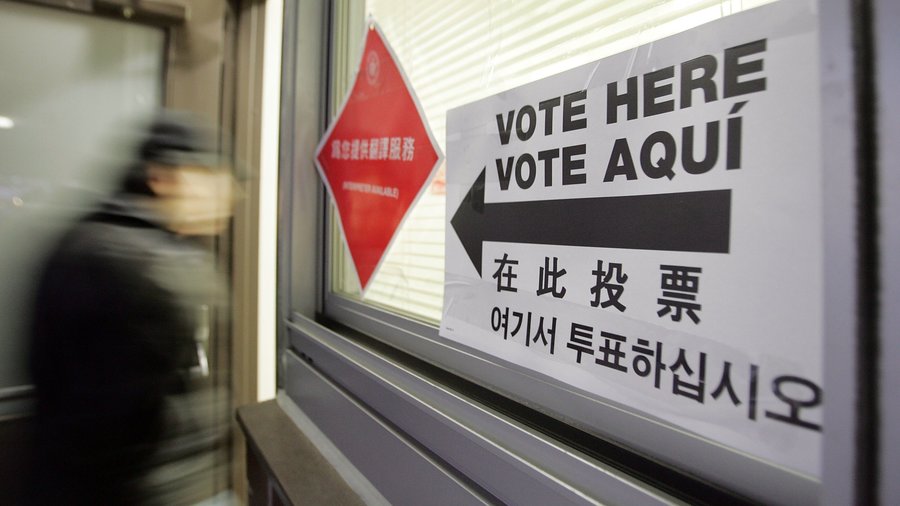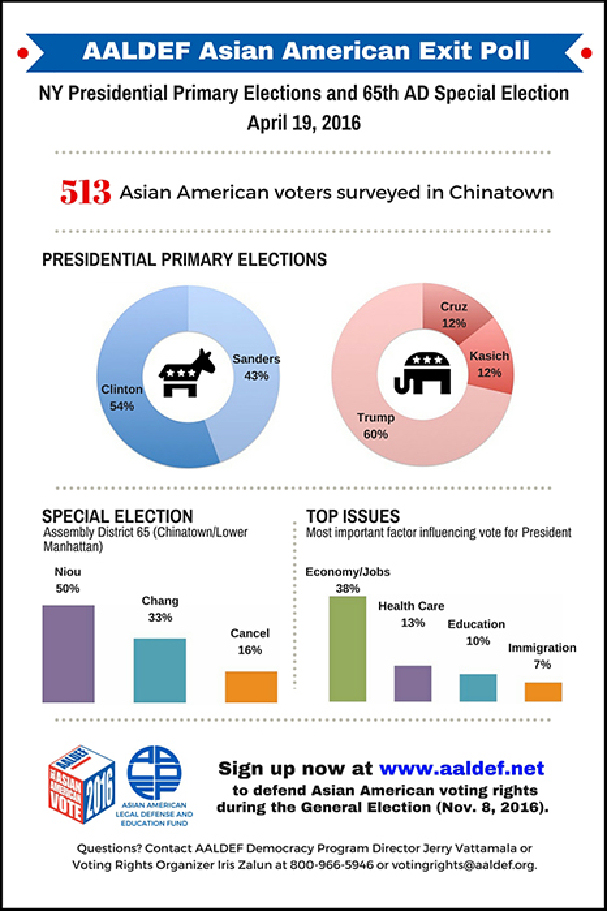
Hillary Clinton advanced one step closer to the Democratic presidential nomination on Tuesday when she faced off against challenger Bernie Sanders in New York State’s primary race — a major prize in the contest for delegate numbers — and emerged victorious. This race was of particular interest to the AAPI community given that New York City boasts the largest single concentration of Asian Americans of any US city: NYC is home to roughly 1 million adult Asian American citizens who represent ~12% of the city’s residents.
Although structural obstacles continue to stymie Asian American voter turnout, roughly 20,000 Asian American voters turned out in New York City on Tuesday to cast a ballot in the Democratic or Republican primary races. Based on New York Times’ exit polling, Asian Americans were 2% of voters who turned out on Tuesday, up from ~1% in 2008.
Too often, mainstream exit pollsters fail to collect a large enough sample of Asian American or Pacific Islander voters to reveal our community’s voting trends. Thankfully, however, the AAPI community has routinely stepped up to meet that challenge.
Today, the Asian American Legal Defense and Education Fund (AALDEF) — which has organized poll monitoring and exit polling of Asian American voters in New York City and across several states for all major election cycles since 1988 — released the results of their 2016 exit poll from Tuesday’s contest. In compiling the results of their survey of 513 Chinese American voters who cast a ballot in Manhattan’s Chinatown on Tuesday, AALDEF reports that those Democrats backed Clinton over Sanders by 54%-43%, and that 60% of polled Chinese American Republicans favoured (exceptionally racist) Donald Trump over challengers John Kasich and Ted Cruz.
 AALDEF was able to achieve this sampling of Chinese American voters in part by conducting their survey in both English and Chinese, and by focusing their efforts on five polling places throughout Chinatown and the Lower East Side to reveal the opinion of these Asian American voters.
AALDEF was able to achieve this sampling of Chinese American voters in part by conducting their survey in both English and Chinese, and by focusing their efforts on five polling places throughout Chinatown and the Lower East Side to reveal the opinion of these Asian American voters.
According to AALDEF’s exit polling, 84% of Chinese American voters were registered Democrats, compared to 8% registered Republicans. 15% were first-time voters, which should be cause for celebration for organizations like AALDEF and others like APIAVote who focus on improving AAPI voter turnout in part by registering new voters.
Like New York City voters at-large, 38% of Chinese American voters cited jobs and the economy as their most important issue in deciding their vote. In preliminary findings from a state-wide survey, AAPIData also recently reported that Asian American New Yorkers cite the economy as a major issue alongside gun control and healthcare; all are issues wherein Clinton typically fare better. In particular, Chinese American New Yorkers’ focus on the economy may have helped propel these voters to cast a vote for Clinton: the New York Times reports that two-thirds of New York voters who cited this as their top issue backed Clinton suggesting that voters might feel she is better equipped to handle the economy as president.
A surprising finding that emerges from AALDEF’s exit polling is that although Chinese American Democratic residents of Manhattan’s Chinatown preferred Clinton over Sanders by a margin of 54-46, overall Clinton won ~59% of the Chinatown and Lower East Side vote. Indeed, across all communities of colour, Clinton’s margin of victory in New York City was lowest among Asian American voters. Furthermore, her support among Asian Americans is lower now in 2016 relative to her popularity in 2008, when 70-90% of Asian American Democrats backed her candidacy against then-challenger Barack Obama. In AALDEF’s own 2008 exit poll of Asian American New York City Democrats, 87% supported Clinton just 8 years ago. That Clinton is now winning over Asian Americans by far lower margins than in years past suggest that she may have lost support among Asian American voters, and that there is ample room for her to regain our interest. (And certainly, her tepid response to her first boba tea encounter recently probably did nothing to help her make inroads.)
Clinton’s issue may have something to do with the fact that she is – by her own admission – a poor campaigner. In New York City, Clinton fared poorly among the 50% of voters who cited honesty and empathy as important candidate qualities in their decision on whom to vote for. In addition, AAPI community organizers have been near unanimous this election cycle in clamouring for both Clinton and Sanders to improve their lukewarm outreach efforts to the AAPI voters. Historically, mainstream political campaigns have struggled to reach out to likely AAPI voters — most reported in a 2014 Asian Americans Advancing Justice Survey that they have never been contacted by any major campaign prior to casting a vote; this election cycle is not shaping up to be much different.
One area where the AAPI community could use greater advocacy is in voter access, itself. A perennial issue for AAPI voters is the problem of language access at the ballots: despite federal stipulations from the 1965 Voting Rights Act requiring in-language ballots be available at polls serving predominantly districts with large populations of English-language-limited voters, polls rarely provide adequate resources to support their ELL voters. Yet, disenfranchisement of ELL voters rarely sparks the interest of mainstream political candidates for higher office. (A new project from 18MillionRising, VoterVox, aims to address this problem on a national level – more on this topic in an upcoming post, so stay tuned!)
AALDEF reports that on Tuesday, they received numerous reports from around Chinatown and the Lower East Side of irregularities at the polls. AALDEF references several voters who experienced “rude”, “hostile” poll workers, including poll workers who failed to provide requested affidavit ballots or directed to the wrong polling site.
Most alarming, however, is the report that many registered voters were unable to find their names on voter rolls, a problem that reminds of a larger voter disenfranchisement debacle in New York this year. In a story that made mainstream headlines, 126,000 Brooklyn voters – or 8% of its active voters between 2015 and 2016 – had their names purged from voter rolls when a Board of Elections’ official skipped a step designed to prevent such an error.
On this, Margaret Fung, Executive Director of AALDEF, said:
We’re encouraged that so many Asian Americans voted in New York’s primary elections. But an improper voter purge of 126,000 Brooklyn voters was just the latest example of the neglect or incompetence of the NYC Board of Elections. In past elections, we’ve seen a lack of Asian interpreters, missing names in voter rolls, improper requests for voter IDs, and racist remarks by poll workers. It’s critical for Asian Americans to vote in the 2016 elections, and AALDEF will challenge barriers to voting that prevent our community from participating fully in our democracy.
AALDEF vows to continue their poll monitoring and exit polling services in 2016’s general election. I invite you to check out AALDEF’s website for more information, and to find out how to support this and their other fantastic work.
